Wenhao Chai
UniHPR: Unified Human Pose Representation via Singular Value Contrastive Learning
Oct 21, 2025Abstract:In recent years, there has been a growing interest in developing effective alignment pipelines to generate unified representations from different modalities for multi-modal fusion and generation. As an important component of Human-Centric applications, Human Pose representations are critical in many downstream tasks, such as Human Pose Estimation, Action Recognition, Human-Computer Interaction, Object tracking, etc. Human Pose representations or embeddings can be extracted from images, 2D keypoints, 3D skeletons, mesh models, and lots of other modalities. Yet, there are limited instances where the correlation among all of those representations has been clearly researched using a contrastive paradigm. In this paper, we propose UniHPR, a unified Human Pose Representation learning pipeline, which aligns Human Pose embeddings from images, 2D and 3D human poses. To align more than two data representations at the same time, we propose a novel singular value-based contrastive learning loss, which better aligns different modalities and further boosts performance. To evaluate the effectiveness of the aligned representation, we choose 2D and 3D Human Pose Estimation (HPE) as our evaluation tasks. In our evaluation, with a simple 3D human pose decoder, UniHPR achieves remarkable performance metrics: MPJPE 49.9mm on the Human3.6M dataset and PA-MPJPE 51.6mm on the 3DPW dataset with cross-domain evaluation. Meanwhile, we are able to achieve 2D and 3D pose retrieval with our unified human pose representations in Human3.6M dataset, where the retrieval error is 9.24mm in MPJPE.
VideoNSA: Native Sparse Attention Scales Video Understanding
Oct 02, 2025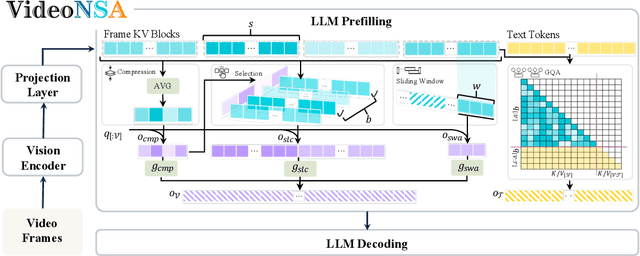
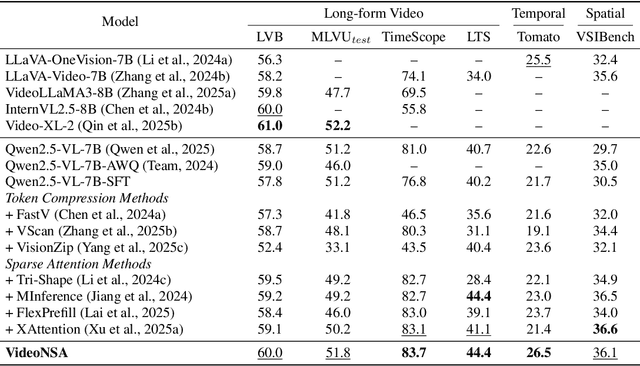
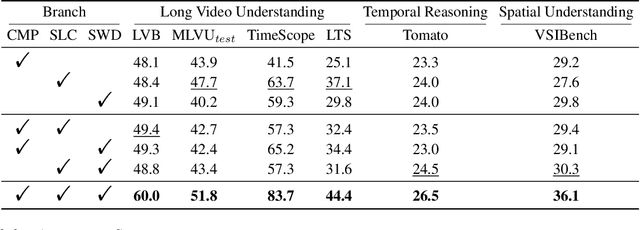
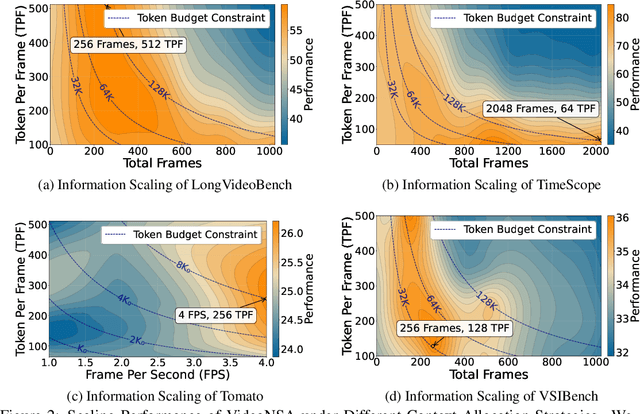
Abstract:Video understanding in multimodal language models remains limited by context length: models often miss key transition frames and struggle to maintain coherence across long time scales. To address this, we adapt Native Sparse Attention (NSA) to video-language models. Our method, VideoNSA, adapts Qwen2.5-VL through end-to-end training on a 216K video instruction dataset. We employ a hardware-aware hybrid approach to attention, preserving dense attention for text, while employing NSA for video. Compared to token-compression and training-free sparse baselines, VideoNSA achieves improved performance on long-video understanding, temporal reasoning, and spatial benchmarks. Further ablation analysis reveals four key findings: (1) reliable scaling to 128K tokens; (2) an optimal global-local attention allocation at a fixed budget; (3) task-dependent branch usage patterns; and (4) the learnable combined sparse attention help induce dynamic attention sinks.
Dense Video Understanding with Gated Residual Tokenization
Sep 18, 2025Abstract:High temporal resolution is essential for capturing fine-grained details in video understanding. However, current video large language models (VLLMs) and benchmarks mostly rely on low-frame-rate sampling, such as uniform sampling or keyframe selection, discarding dense temporal information. This compromise avoids the high cost of tokenizing every frame, which otherwise leads to redundant computation and linear token growth as video length increases. While this trade-off works for slowly changing content, it fails for tasks like lecture comprehension, where information appears in nearly every frame and requires precise temporal alignment. To address this gap, we introduce Dense Video Understanding (DVU), which enables high-FPS video comprehension by reducing both tokenization time and token overhead. Existing benchmarks are also limited, as their QA pairs focus on coarse content changes. We therefore propose DIVE (Dense Information Video Evaluation), the first benchmark designed for dense temporal reasoning. To make DVU practical, we present Gated Residual Tokenization (GRT), a two-stage framework: (1) Motion-Compensated Inter-Gated Tokenization uses pixel-level motion estimation to skip static regions during tokenization, achieving sub-linear growth in token count and compute. (2) Semantic-Scene Intra-Tokenization Merging fuses tokens across static regions within a scene, further reducing redundancy while preserving dynamic semantics. Experiments on DIVE show that GRT outperforms larger VLLM baselines and scales positively with FPS. These results highlight the importance of dense temporal information and demonstrate that GRT enables efficient, scalable high-FPS video understanding.
AuroraLong: Bringing RNNs Back to Efficient Open-Ended Video Understanding
Jul 03, 2025Abstract:The challenge of long video understanding lies in its high computational complexity and prohibitive memory cost, since the memory and computation required by transformer-based LLMs scale quadratically with input sequence length. We propose AuroraLong to address this challenge by replacing the LLM component in MLLMs with a linear RNN language model that handles input sequence of arbitrary length with constant-size hidden states. To further increase throughput and efficiency, we combine visual token merge with linear RNN models by reordering the visual tokens by their sizes in ascending order. Despite having only 2B parameters and being trained exclusively on public data, AuroraLong achieves performance comparable to Transformer-based models of similar size trained on private datasets across multiple video benchmarks. This demonstrates the potential of efficient, linear RNNs to democratize long video understanding by lowering its computational entry barrier. To our best knowledge, we are the first to use a linear RNN based LLM backbone in a LLaVA-like model for open-ended video understanding.
LiveCodeBench Pro: How Do Olympiad Medalists Judge LLMs in Competitive Programming?
Jun 13, 2025Abstract:Recent reports claim that large language models (LLMs) now outperform elite humans in competitive programming. Drawing on knowledge from a group of medalists in international algorithmic contests, we revisit this claim, examining how LLMs differ from human experts and where limitations still remain. We introduce LiveCodeBench Pro, a benchmark composed of problems from Codeforces, ICPC, and IOI that are continuously updated to reduce the likelihood of data contamination. A team of Olympiad medalists annotates every problem for algorithmic categories and conducts a line-by-line analysis of failed model-generated submissions. Using this new data and benchmark, we find that frontier models still have significant limitations: without external tools, the best model achieves only 53% pass@1 on medium-difficulty problems and 0% on hard problems, domains where expert humans still excel. We also find that LLMs succeed at implementation-heavy problems but struggle with nuanced algorithmic reasoning and complex case analysis, often generating confidently incorrect justifications. High performance appears largely driven by implementation precision and tool augmentation, not superior reasoning. LiveCodeBench Pro thus highlights the significant gap to human grandmaster levels, while offering fine-grained diagnostics to steer future improvements in code-centric LLM reasoning.
Muddit: Liberating Generation Beyond Text-to-Image with a Unified Discrete Diffusion Model
May 29, 2025Abstract:Unified generation models aim to handle diverse tasks across modalities -- such as text generation, image generation, and vision-language reasoning -- within a single architecture and decoding paradigm. Autoregressive unified models suffer from slow inference due to sequential decoding, and non-autoregressive unified models suffer from weak generalization due to limited pretrained backbones. We introduce Muddit, a unified discrete diffusion transformer that enables fast and parallel generation across both text and image modalities. Unlike prior unified diffusion models trained from scratch, Muddit integrates strong visual priors from a pretrained text-to-image backbone with a lightweight text decoder, enabling flexible and high-quality multimodal generation under a unified architecture. Empirical results show that Muddit achieves competitive or superior performance compared to significantly larger autoregressive models in both quality and efficiency. The work highlights the potential of purely discrete diffusion, when equipped with strong visual priors, as a scalable and effective backbone for unified generation.
GAM-Agent: Game-Theoretic and Uncertainty-Aware Collaboration for Complex Visual Reasoning
May 29, 2025Abstract:We propose GAM-Agent, a game-theoretic multi-agent framework for enhancing vision-language reasoning. Unlike prior single-agent or monolithic models, GAM-Agent formulates the reasoning process as a non-zero-sum game between base agents--each specializing in visual perception subtasks--and a critical agent that verifies logic consistency and factual correctness. Agents communicate via structured claims, evidence, and uncertainty estimates. The framework introduces an uncertainty-aware controller to dynamically adjust agent collaboration, triggering multi-round debates when disagreement or ambiguity is detected. This process yields more robust and interpretable predictions. Experiments on four challenging benchmarks--MMMU, MMBench, MVBench, and V*Bench--demonstrate that GAM-Agent significantly improves performance across various VLM backbones. Notably, GAM-Agent boosts the accuracy of small-to-mid scale models (e.g., Qwen2.5-VL-7B, InternVL3-14B) by 5--6\%, and still enhances strong models like GPT-4o by up to 2--3\%. Our approach is modular, scalable, and generalizable, offering a path toward reliable and explainable multi-agent multimodal reasoning.
TEMPURA: Temporal Event Masked Prediction and Understanding for Reasoning in Action
May 02, 2025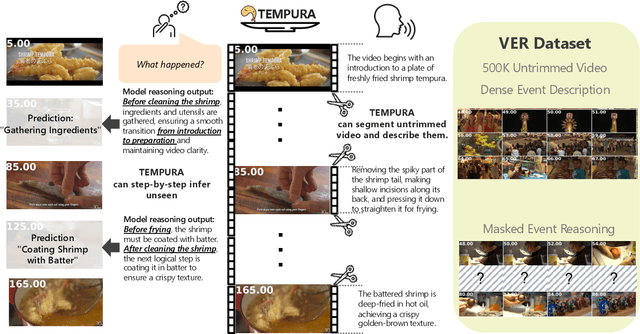

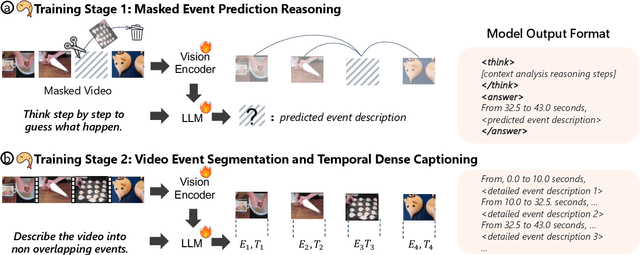
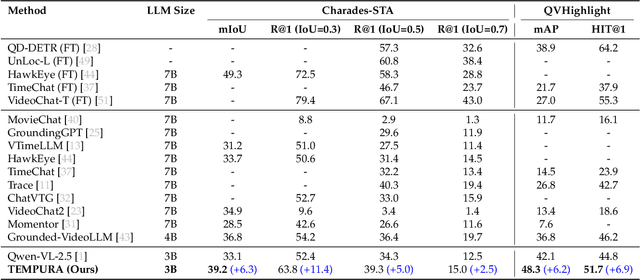
Abstract:Understanding causal event relationships and achieving fine-grained temporal grounding in videos remain challenging for vision-language models. Existing methods either compress video tokens to reduce temporal resolution, or treat videos as unsegmented streams, which obscures fine-grained event boundaries and limits the modeling of causal dependencies. We propose TEMPURA (Temporal Event Masked Prediction and Understanding for Reasoning in Action), a two-stage training framework that enhances video temporal understanding. TEMPURA first applies masked event prediction reasoning to reconstruct missing events and generate step-by-step causal explanations from dense event annotations, drawing inspiration from effective infilling techniques. TEMPURA then learns to perform video segmentation and dense captioning to decompose videos into non-overlapping events with detailed, timestamp-aligned descriptions. We train TEMPURA on VER, a large-scale dataset curated by us that comprises 1M training instances and 500K videos with temporally aligned event descriptions and structured reasoning steps. Experiments on temporal grounding and highlight detection benchmarks demonstrate that TEMPURA outperforms strong baseline models, confirming that integrating causal reasoning with fine-grained temporal segmentation leads to improved video understanding.
Video-MMLU: A Massive Multi-Discipline Lecture Understanding Benchmark
Apr 20, 2025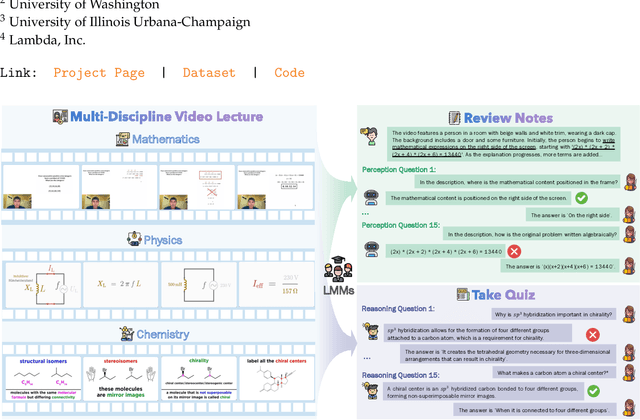

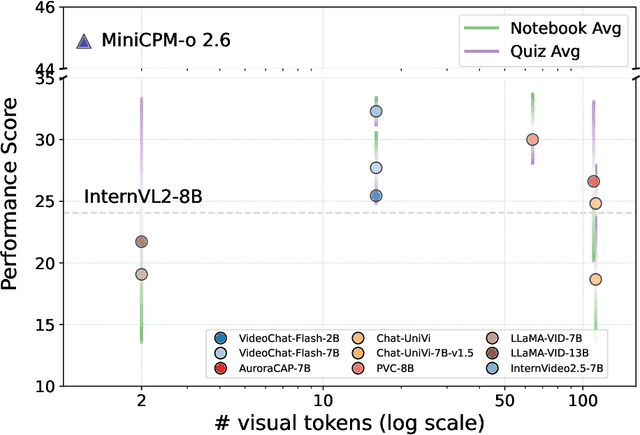
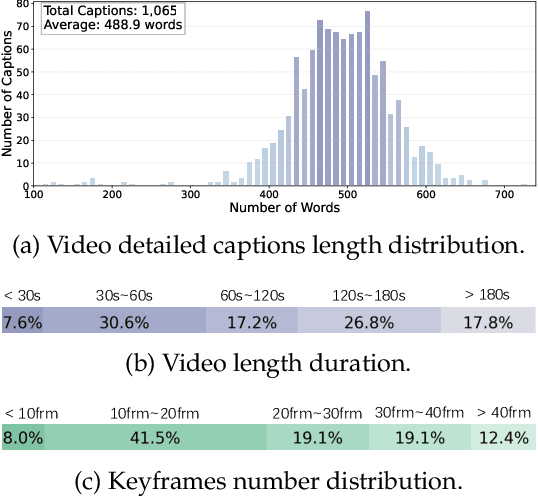
Abstract:Recent advancements in language multimodal models (LMMs) for video have demonstrated their potential for understanding video content, yet the task of comprehending multi-discipline lectures remains largely unexplored. We introduce Video-MMLU, a massive benchmark designed to evaluate the capabilities of LMMs in understanding Multi-Discipline Lectures. We evaluate over 90 open-source and proprietary models, ranging from 0.5B to 40B parameters. Our results highlight the limitations of current models in addressing the cognitive challenges presented by these lectures, especially in tasks requiring both perception and reasoning. Additionally, we explore how the number of visual tokens and the large language models influence performance, offering insights into the interplay between multimodal perception and reasoning in lecture comprehension.
Science-T2I: Addressing Scientific Illusions in Image Synthesis
Apr 17, 2025Abstract:We present a novel approach to integrating scientific knowledge into generative models, enhancing their realism and consistency in image synthesis. First, we introduce Science-T2I, an expert-annotated adversarial dataset comprising adversarial 20k image pairs with 9k prompts, covering wide distinct scientific knowledge categories. Leveraging Science-T2I, we present SciScore, an end-to-end reward model that refines the assessment of generated images based on scientific knowledge, which is achieved by augmenting both the scientific comprehension and visual capabilities of pre-trained CLIP model. Additionally, based on SciScore, we propose a two-stage training framework, comprising a supervised fine-tuning phase and a masked online fine-tuning phase, to incorporate scientific knowledge into existing generative models. Through comprehensive experiments, we demonstrate the effectiveness of our framework in establishing new standards for evaluating the scientific realism of generated content. Specifically, SciScore attains performance comparable to human-level, demonstrating a 5% improvement similar to evaluations conducted by experienced human evaluators. Furthermore, by applying our proposed fine-tuning method to FLUX, we achieve a performance enhancement exceeding 50% on SciScore.
 Add to Chrome
Add to Chrome Add to Firefox
Add to Firefox Add to Edge
Add to Edge